Alaska’s Absent Snowy Owls
The only reliable snowy owl breeding site in the United States has a conspicuous shortage of owls.
Article body copy
A male snowy owl hovers briefly, aloft in the breezy Arctic air, before diving at field researcher Denver Holt. The bright-white bird descends within a meter of the man, making short, loud barks before retreating and swooping again. Holt is undeterred. In a few more strides, he reaches the owl’s nest—a bowl-shaped depression scraped out of the top of a mound—and crouches on his knees to quickly count the eggs and chicks inside. After decades on this landscape, he isn’t rattled by incoming talons. “I get hit on the head, the shoulders, the neck, all the time,” he says, his brown hair, accented with gray, tucked under a baseball cap with an owl on it. “One time a female ripped right through my Carhartt [pants], right through my long johns, and left four punctures on my butt. She got me good.”
This nest is particularly important. At the end of June, two of its young inhabitants are downy and chirping with eyes squeezed shut, and the remaining three are still in shells, soon to hatch. It’s one of only three active nests Holt has found after weeks crisscrossing a peninsula squeezed between the Chukchi and Beaufort Seas outside Utqiaġvik (formerly known as Barrow), Alaska, and the only one where chicks hatched. Before the summer is out, he’ll find just one more nest. It fails, too.
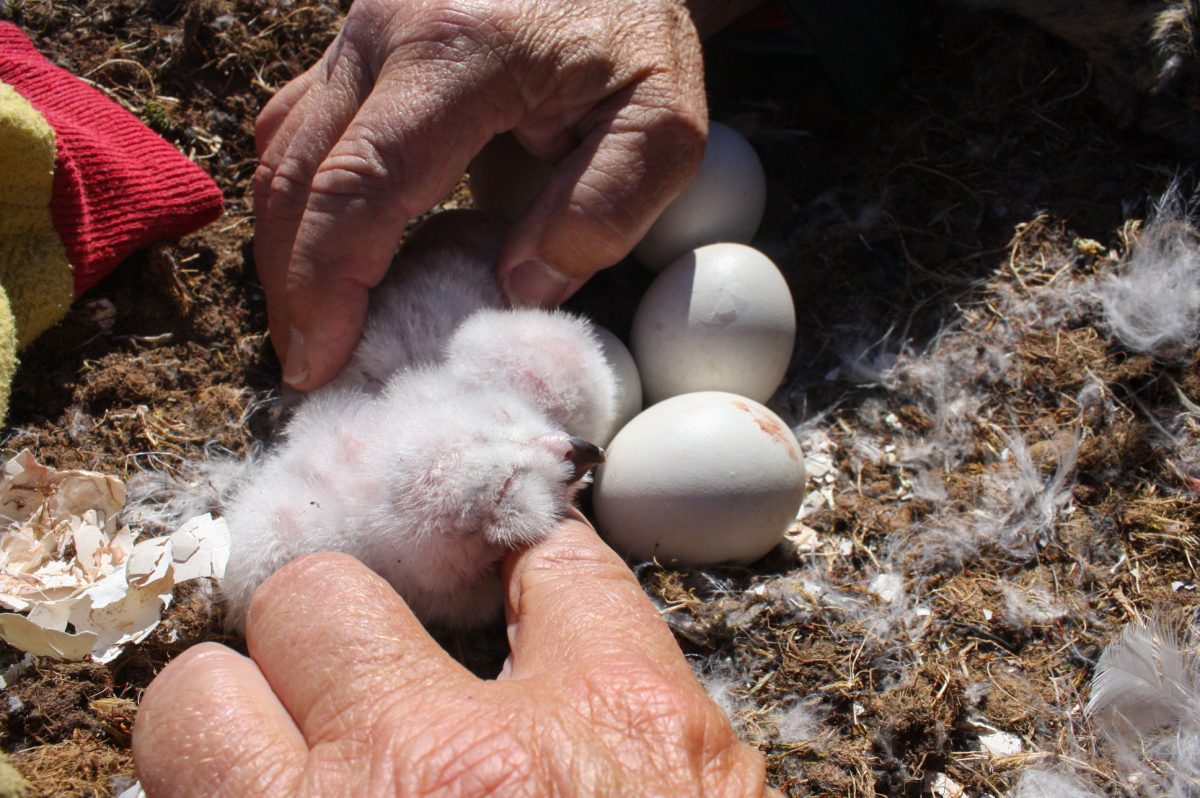
Snowy owl chicks, just a few days old, huddle together for warmth while field researcher Denver Holt checks their size and plumage development. Photo by Kylie Mohr
This past summer marked the 30th year that Holt has studied the snowy owls of Alaska, operating through the Owl Research Institute, a nonprofit he founded in Montana. He and his colleagues spend much of their time working on owl projects in the state. But each June, he migrates north, just as snowy owls do earlier in the spring, relocating to Utqiaġvik, the largest city in Alaska’s North Slope Borough, with about 4,400 residents, as well as numerous visiting researchers and the occasional gaggle of birdwatchers. Some owls are known to overwinter here, where they spend the majority of their lives, but most relocate for the coldest months of the year to southeastern Canada; the United States as far south as Texas and Florida; and Russia.
As the birds settle in to tend their broods, Holt trudges on foot or by ATV across the tundra, sometimes with help, but often alone. He’s dogged in his efforts to understand snowy owl populations and breeding trends and how they relate to the abundance of brown lemmings, the owls’ primary food source in the Utqiaġvik area. What he’s seen in the past few years troubles him—nests are declining.
In 1995, Holt documented a record 54 nests across his 214-square-kilometer study area and had to ask friends from Montana to leave their bartending jobs to help monitor them. In 2020, he found none. “Why did the snowy owls start disappearing from Barrow?” he says. “It’s too quiet out here. Eerily quiet.” This year, the breeding site—the only place in the United States where snowy owls regularly breed—now resembles more of a bachelor pad. There are more single male owls than mating pairs.
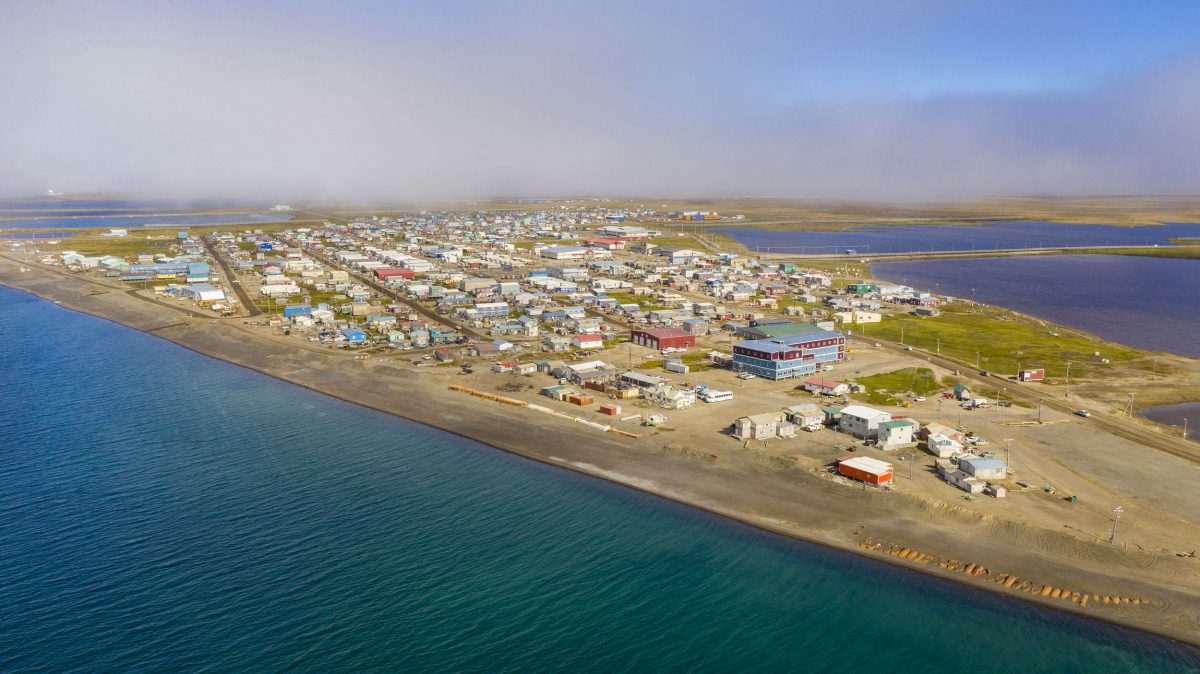
Utqiaġvik, Alaska, the northernmost US city, has history as a place Iñupiat hunted snowy owls. Photo by Zoonar GmbH/Alamy Stock Photo
Holt leads the way across the treeless tundra, past ponds and pipelines that run between the three natural gas fields in the area and the town. He points out meter-high knolls that used to see regular nests. It feels like I’m touring a ghost town.
The lemmings, which Holt catches with snap traps, are also notably absent. Snowy owls can take advantage of the coastal environment around Utqiaġvik, supplementing their diet with ducks, shorebirds, and gulls (some, like the jaeger—a relative of gulls—may eat owl eggs in return). They can hunt on the ice or at areas of open water surrounded by sea ice, known as polynyas, plucking prey from the water’s surface. But Holt has found that during breeding season, lemmings make up 90 percent of their diet—and their diets aren’t shifting as lemmings decline. Parents must stay close to their offspring, so they nest where they can find enough of the rodents nearby. Holt believes there are sufficient lemmings for the owls to survive on, but not enough to fuel widespread breeding or sustain chicks. Females, he suggests, may come into the area, realize there’s not enough food, and go elsewhere.
The steady decline of both snowy owl nests and lemming abundance began just over a decade ago. Lemmings are known for booms and busts, but they’ve historically occurred here with regularity despite those fluctuations. Now, one bad year is followed by another and another. “Although the lemming populations still fluctuate, the highs are lower than they used to be,” Holt says. “It’s the same thing with snowy owls.”
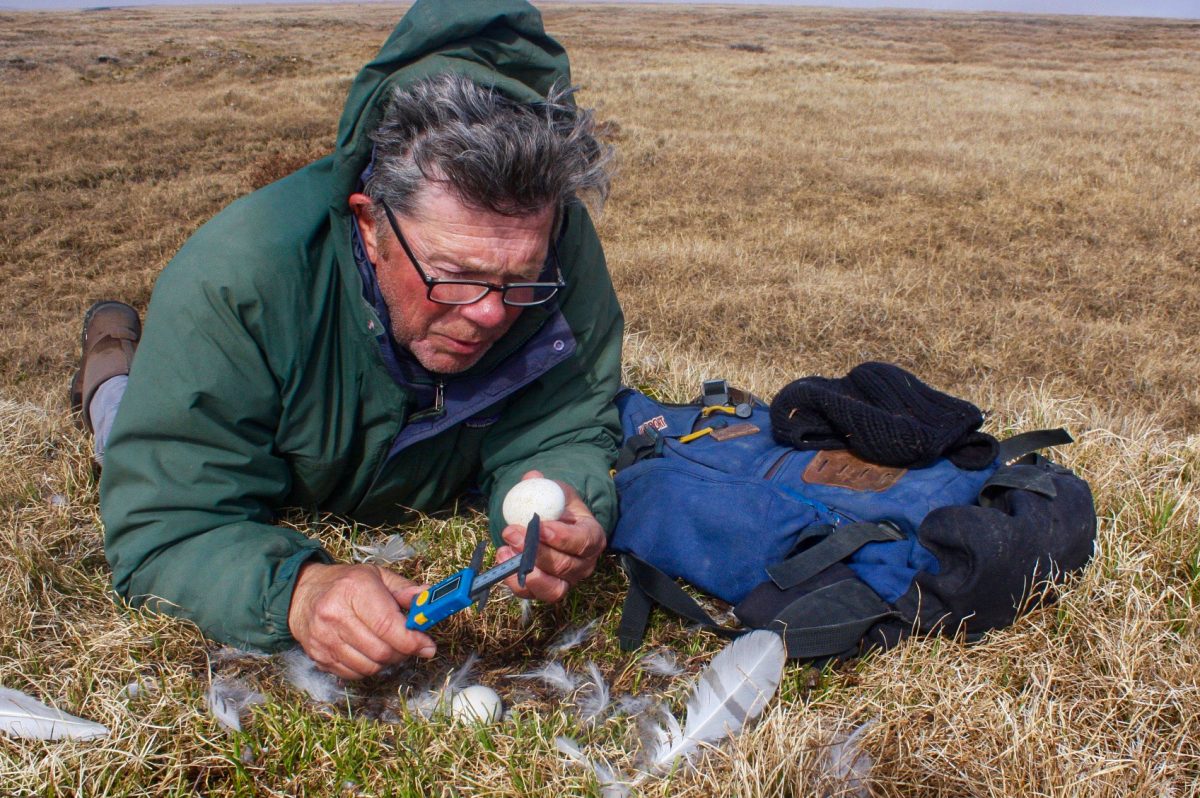
Holt measures eggs at a snowy owl nest on the tundra. The eggs at this nest site failed to hatch. Photo by Kylie Mohr
There’s a real possibility that snowy owls will stop breeding here—and sooner, rather than later. Holt is quick to point out that the downward slide could reverse at any time—in just a year, the animals could be headed for a comeback. Yet over the past couple of years, the data has made him increasingly concerned that breeding owls are not going to rebound. “There could be one good year, but it’s not good overall.”
If the breeding site collapses, it might be yet another symptom of climate change, though Holt hasn’t ruled out other possibilities. All he can do now is watch for patterns and try to make sense of them, hoping they’ll eventually lead him toward answers.
The owls’ breeding ground, the tundra, feels vast. The ground, dotted with fuchsia wooly lousewort flowers and snow buttercup, is soggy. Each step pulls at our feet and threatens to suck them into the marshy lowlands. Winds coming off the ice try to blow us over and make holding binoculars steady nearly impossible. Here, an eight-kilometer hike feels like 16. “It takes me a week to get my tundra legs,” says Holt, who loses up to 4.5 kilograms each summer. He subsists on nuts and chocolate and recharges with the occasional “tundra nap” on a bed of lichen.
Holt’s work in the Arctic is the longest-running study of breeding snowy owls and their young in North America. “It takes time not only to gather good data, but for you to become a good researcher,” he says. With leather binocular straps around his neck and a navy JanSport backpack on his back, he has recorded data on chick growth rates, body mass, plumage development, and details like when the babies’ eyes open. He’s compared lemming numbers with measures of nest success, like how many eggs are laid, hatched, and eventually fledged. He has located nearly 300 nests, banded over 750 chicks, dissected 14,000 or so pellets (the owls’ regurgitated undigested food), and in the process, created a definitive record of snowy owl breeding population trends for the region.
And now, watching an ecosystem that’s faltering—or at least changing—Holt feels a sense of responsibility and an insatiable curiosity to keep searching for answers. “I want to learn as much as I can for their conservation and to make sure we always have [the owls],” Holt says. “I’m afraid I’ll miss the most important event, so I’m going to keep going, keep learning, until I’m forced to quit.”
It’s hard to know if the owls missing from Utqiaġvik are simply relocating in search of lemmings, Holt says—their breeding territory extends far beyond this study site, to Canada, northern Europe, Scandinavia, Iceland, and Russia. But there are indications that the birds’ global population is in decline. The International Union for Conservation of Nature’s (IUCN) Red List of Threatened Species, which marked the snowy owl’s status as vulnerable for the first time in 2017, notes that there’s uncertainty in the estimates, but snowy owl populations appear to be dropping rapidly in North America, and likely in northern Europe and Russia. The organization suggests the species is likely to decline worldwide by at least 30 to 49 percent in three generations.
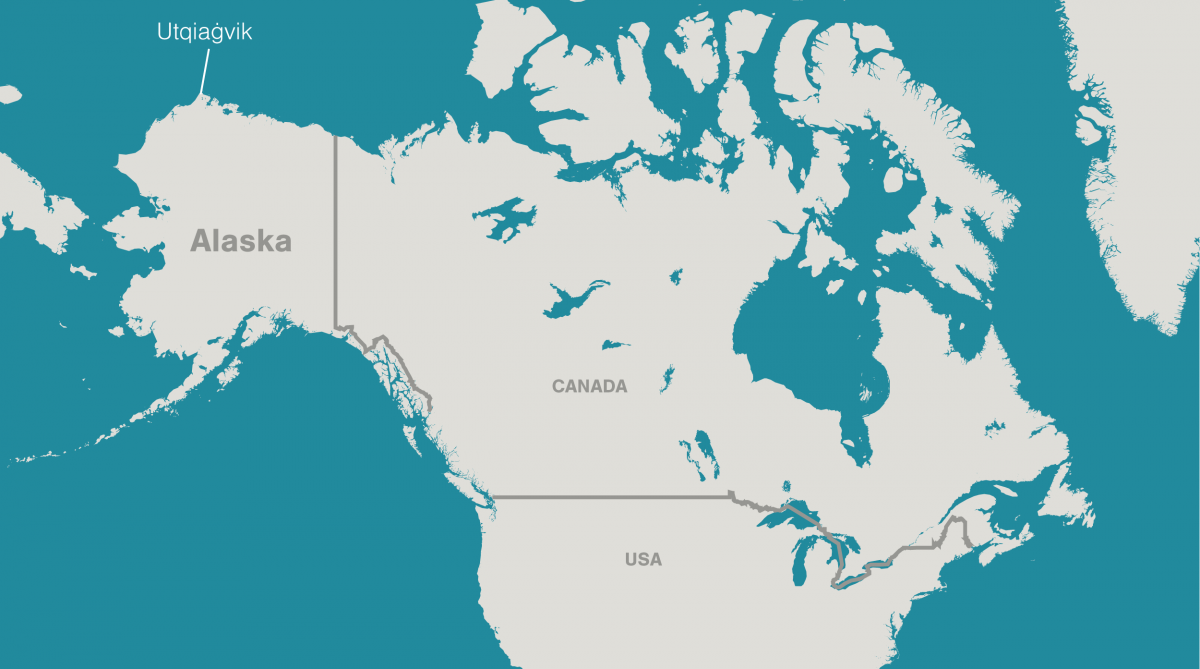
Though Utqiaġvik is at the northern tip of Alaska, it is actually at the southern end of the snowy owl’s range map and appears to be changing faster than other breeding sites. Map data by OpenStreetMap via ArcGIS
Lemmings, Holt thinks, could be the best indicator of environmental change in Utqiaġvik. But since it seems to him that “nobody cares about lemmings except for me and maybe 20 other people in the world,” it’s up to the snowy owl to act as an alarm bell for itself and all the other wildlife—from Arctic foxes to gulls, jaegers, and weasels—that prey on the rodents, too.
His deep look at snowy owl population trends over time offers insight into one of the fastest-changing parts of the globe; in 2018, researchers determined that surface air temperatures in the Arctic are warming twice as fast as the rest of the world.
According to the 2020 Arctic Report Card, the Arctic is changing biologically as it becomes warmer and less frozen. The IUCN list mentions climate change’s alteration and shifting of habitat as one of many threats to the owls. Although Utqiaġvik may look northern on a map to most, it’s actually at the southern edge of the species’ breeding range. “It’s not a surprise one of the first few places to document a decline in breeding would be northern Alaska,” says biologist Jean-Francois Therrien, who has studied movement ecology of snowy owls, mostly in the eastern Canadian Arctic, for decades and worked with Holt in 2018 to put trackers on snowy owls. He isn’t sure precisely how climate change could be affecting the owls and their nests. Warmer winters result in more rain, which forms a frozen ice crust on the tundra. Could this impact lemmings, which burrow into the snow for insulation? “Climate effects, they’re not a straightforward mechanism,” Therrien says. “Obviously, if you increase temperatures by a few degrees, you don’t kill a snowy owl right away. It’s through the food web, through interactions with other species.”
The Owl Research Institute was awarded a grant in 2017 to determine whether climate change is causing the nest decline. Holt plans to pair his own data with information from the National Weather Service, Barrow Atmospheric Baseline Observatory, and other sources, and he recently hired help to do so. He’s wary of pointing the finger at climate change alone without further analysis. It could be something else entirely. North American birds are struggling as a whole; a prominent 2019 study showed that birds in the United States and Canada have declined by nearly three billion, or 29 percent, over the past 50 years. Holt is also entertaining a hypothesis that geese might play a role—the US Fish and Wildlife Service culled Arctic foxes near Utqiaġvik from 2005 to 2016 to protect the threatened Steller’s eider. Because foxes also prey on geese eggs and chicks, their decline may have contributed to an increase of geese in the area. Today, several types of geese are eating the grasses that lemmings hide in and eat, which could mean that the lemmings are more readily spotted by predators or are going hungry.
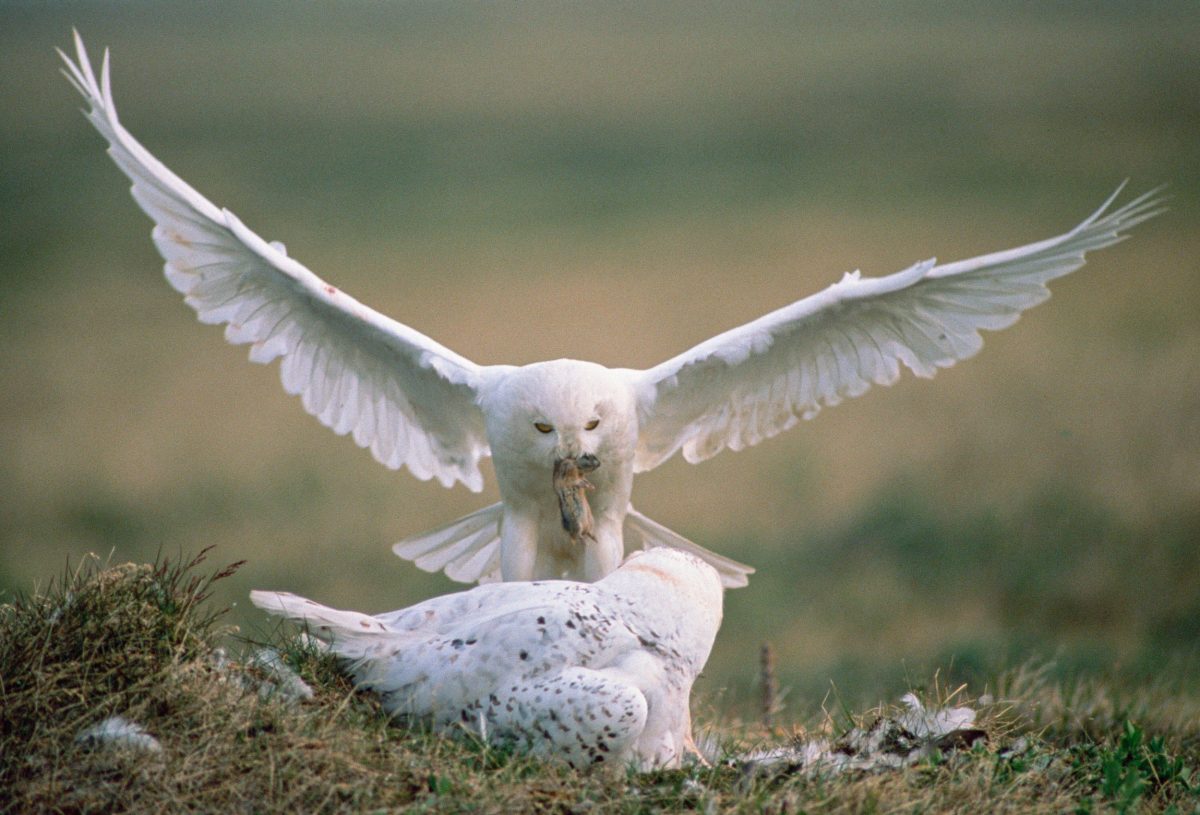
Snowy owl breeding pairs share parenting responsibilities, which include providing a steady supply of lemmings. Adult males tend to be pure white and females generally have some barring. Photo by Michio Hoshino/Minden Pictures
If the trend continues and snowy owls stop having their young in Utqiaġvik, their loss will be noticed by the Iñupiat. Ukpeaġvik, an original name for this area, means “place to hunt snowy owls.” While the owls and their eggs aren’t typically consumed today, elders remember the taste. Iñupiaq Christopher Savok says that owls—along with caribou, whales, seals, fish, and other birds—played an important role in the traditional diet. “Snowy owls are ingrained in our culture,” Savok says. The birds have been part of the landscape for thousands of years and are iconic to the region—carvers depict them on bowhead whale vertebrae and walrus tusk ivory for souvenirs.
Savok grew up exploring the tundra and was assigned to work with Holt as a North Slope Borough Department of Wildlife Management summer field technician. In the early years of the snowy owl project, he was one of the community members who showed Holt how to find nests. Though he doesn’t work with wildlife anymore, he keeps an eye out for the owls when Holt’s not around, sometimes texting him with updates. The environment wouldn’t be the same without them, he says. “Everything does play a role.”
On my trip to Utqiaġvik, Holt and I split our days between searching for new nests and checking the few we’ve found to record information on the chicks’ growth and plumage, as well as parental behavior and the number of dead lemmings the adults have stockpiled nearby to feed to their young. He attempts to minimize his impact, staying only for a few minutes and checking to make sure the female returns before leaving the area completely. “Look for the white,” he says, when instructing me on how to search the tundra. “It’s either a plastic bag, a piece of styrofoam, or a snowy owl.” We walk to small ridges or sometimes climb on top of abandoned industrial boxes and old gas field buildings for a better look out over the landscape. Caribou skulls bleached by the elements, swans, and gulls frequently dupe us.
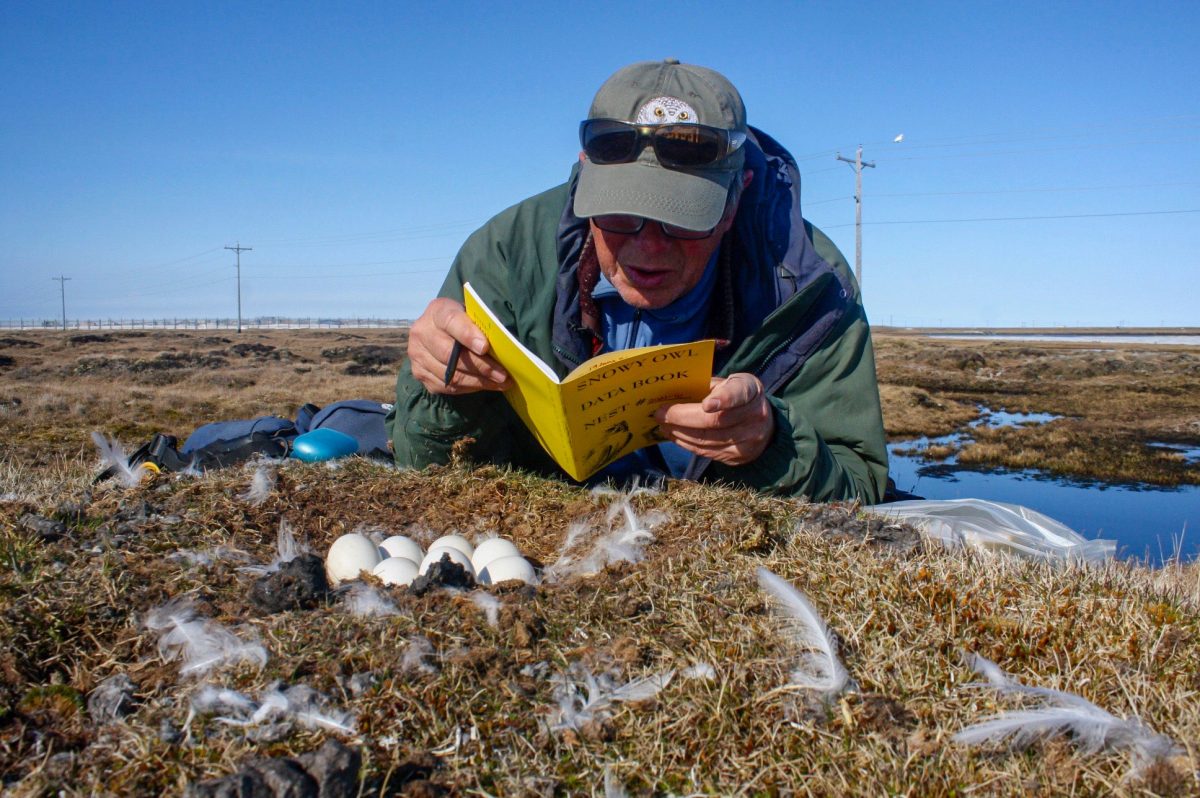
A male snowy owl perches on a telephone pole behind Holt as the researcher records data in a notebook. The owl will keep an eye on its nest, swooping and hooting, until Holt leaves. Photo by Kylie Mohr
Back at the one surviving nest, Holt is ecstatic when eggs begin to hatch. “There’s one! Two!” he yelps. I hold a soon-to-hatch egg in my hand, marveling at its warmth and listening to the bird cracking away at the shell from inside. He talks to the adults as he measures their eggs and weighs their chicks. “Sorry, babe,” he calls to the mother, who left the nest momentarily in an attempt to obfuscate its location and distract us. “We’ll leave soon.” To the aggressive, swooping male he says, “I like you! I think they’re going to pull this off.” Males and females have different roles but together protect and feed their young until they fledge. In this case, all five chicks will make it to the end of the summer. As we walk away, Holt says the chicks hatching “makes it all worth it.”
His enthusiasm wanes when we watch an opportunistic jaeger swoop in and pillage another nest shortly after we find it, when we find evidence of a failed nest farther inland, and when we revisit a nest to find its only two eggs are gone. A male briefly perches on the mound before flying away, as though he hasn’t quite come to terms with having no more offspring to protect. Holt cares fiercely about the birds. “I get too sentimental,” he says. “I’m too attached.” He blames it on getting older; I suspect he’s had a soft spot for the owls all along. What will he do if the ecosystem he’s studied for his whole career has run out of time, shifting to a new reality? “It’ll bother me terribly,” Holt says. “But I’ll have chronicled it. Our research will stand the test of time.” With painstaking care and dedication, he finds comfort in scientifically bearing witness.

